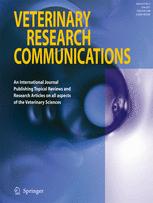View Item
- xmlui.general.dspace_homeCentros Regionales y EEAsCentro Regional Santa FeEEA RafaelaArtículos científicosxmlui.ArtifactBrowser.ItemViewer.trail
- DSpace Home
- Centros Regionales y EEAs
- Centro Regional Santa Fe
- EEA Rafaela
- Artículos científicos
- View Item
Genotypic and phenotypic detection of capsular polysaccharide and biofilm formation in Staphylococcus aureus isolated from bovine milk collected from Brazilian dairy farms
Abstract
Staphylococcus aureus is a pathogen that frequently causes mastitis in bovine herds worldwide. This pathogen produces several virulence factors, including cell-associated adhesins, toxic and cytolytic exoproteins, and capsular polysaccharides. The aim of the present study was to test for the presence of genes involved in capsular polysaccharide production and biofilm formation in S. aureus isolated from bovine mastitis samples collected from 119 dairy
[ver mas...]
Staphylococcus aureus is a pathogen that frequently causes mastitis in bovine herds worldwide. This pathogen produces several virulence factors, including cell-associated adhesins, toxic and cytolytic exoproteins, and capsular polysaccharides. The aim of the present study was to test for the presence of genes involved in capsular polysaccharide production and biofilm formation in S. aureus isolated from bovine mastitis samples collected from 119 dairy herds located in three different Brazilian regions, as well as to assay the production of capsular polysaccharides and biofilm, in vitro. The detection of the cap, icaAD, and bap genes was performed using PCR. The detection and quantification of capsular polysaccharide production was performed using ELISA assays. The ability of the isolates to form a biofilm was examined using the polystyrene surface of microtiter plates. All 159 S. aureus isolates investigated harboured the cap gene: 80 % carried the cap5 gene and 20 % carried the cap8 gene. Sixty-nine percent of the isolates expressed capsular polysaccharide (CP) in vitro, 58 % expressed CP5 and 11 % expressed CP8. All of the isolates harboured the icaA and icaD genes, and 95.6 % of the isolates carried the bap gene. Of the 159 isolates analysed, 97.5 % were biofilm producers. A significant association between the capsular genotype and phenotype and the amount of biofilm formation was detected: cap5/CP5 isolates tended to form more biofilm and to produce a thinner CP layer than cap8/CP8 isolates. The results indicate a high potential for pathogenicity among S. aureus isolated from bovine milk collected from three different regions in Brazil.
[Cerrar]

Author
Salimena, Alessandra P.S.;
Lange, Carla C.;
Camussone, Cecilia;
Signorini, Marcelo;
Calvinho, Luis Fernando;
Brito, María A.V.P.;
Borges, Cristiano A.V.;
Guimaraes, Alessandro S.;
Ribeiro, Joao B.;
Mendonca, Leticia C.;
Piccoli, Roberta H.;
Fuente
Veterinary research communications 40 (3-4) : 97-106. (2016)
Date
2016-12
ISSN
1573-7446
Formato
pdf
Tipo de documento
article
Palabras Claves
Derechos de acceso
Restringido
 Excepto donde se diga explicitamente, este item se publica bajo la siguiente descripción: Creative Commons Attribution-NonCommercial-ShareAlike 2.5 Unported (CC BY-NC-SA 2.5)
Excepto donde se diga explicitamente, este item se publica bajo la siguiente descripción: Creative Commons Attribution-NonCommercial-ShareAlike 2.5 Unported (CC BY-NC-SA 2.5)

